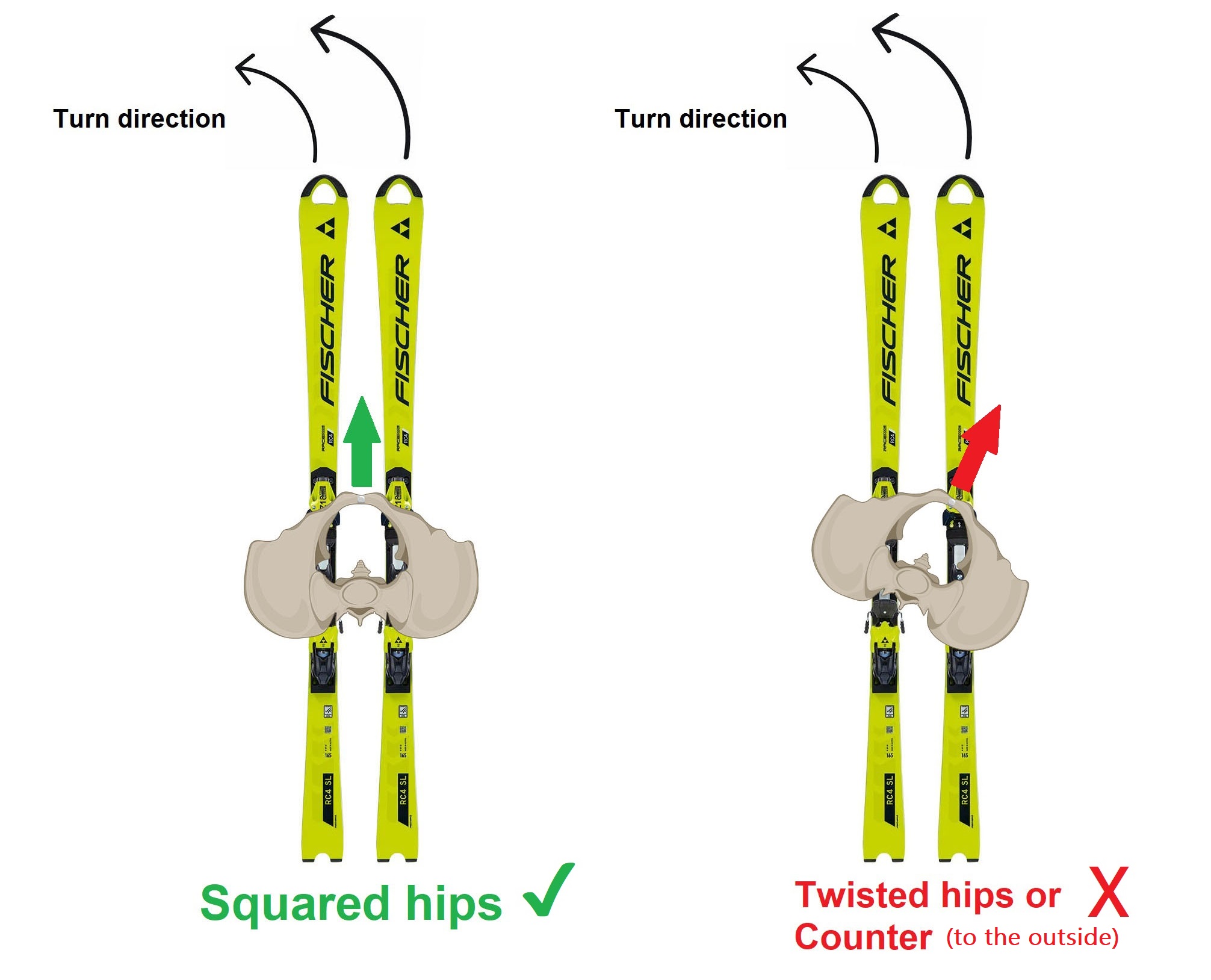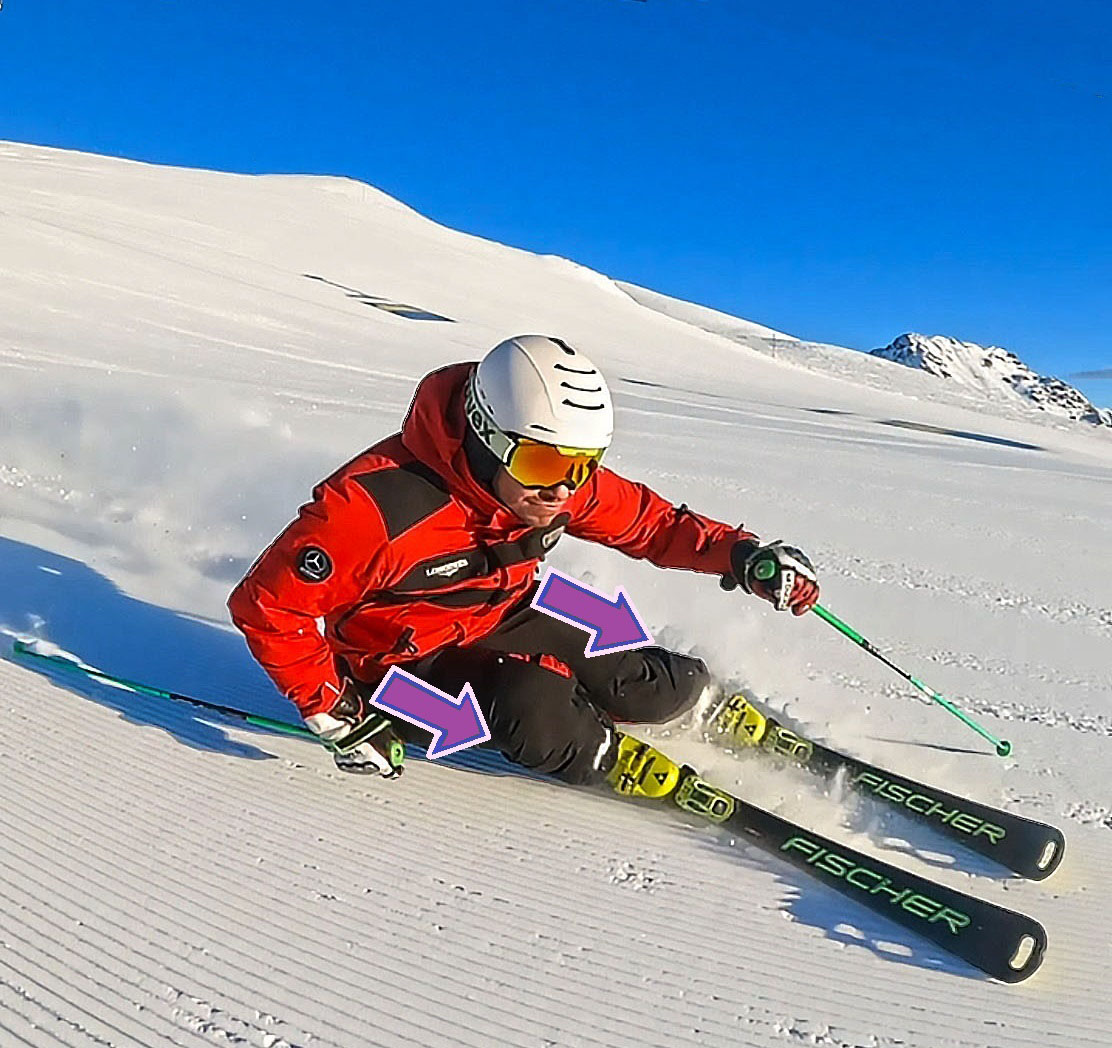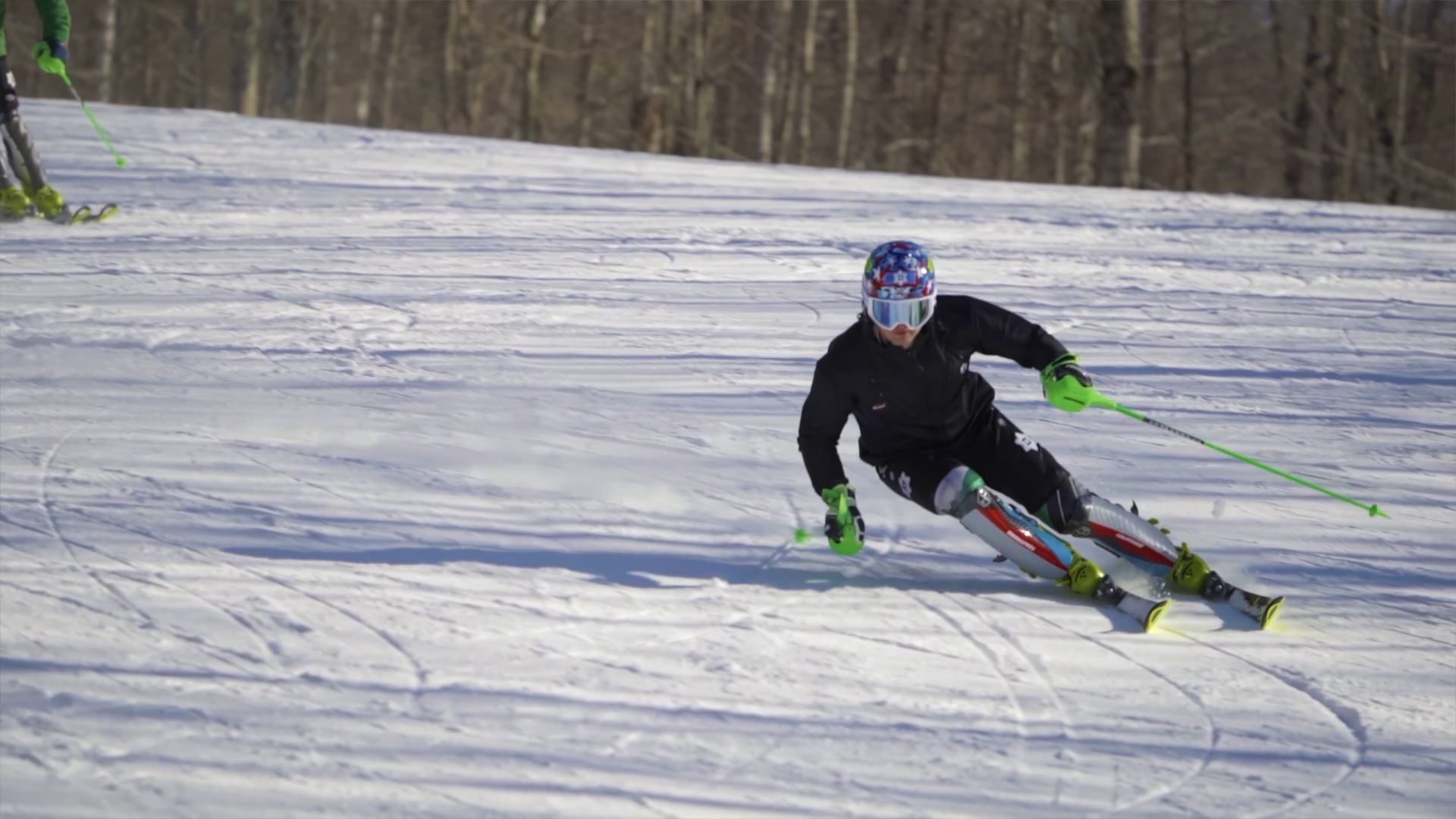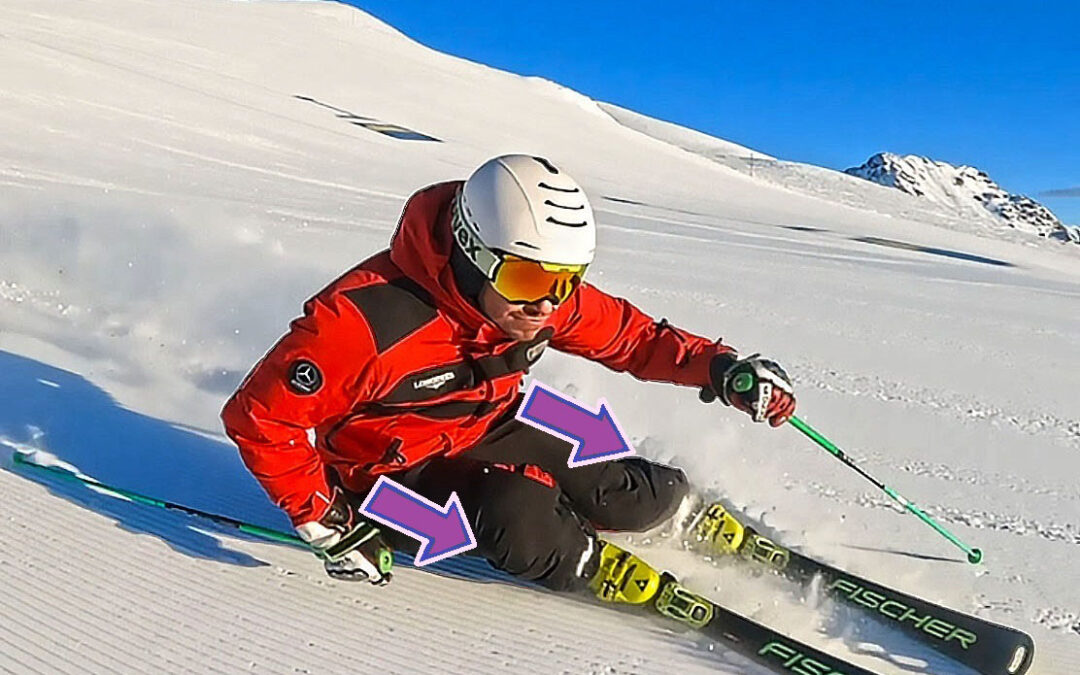Even though the position and movements of the hips throughout the turn are a key aspect in high-level skiing, not many ski instructors teach to the hips often. I think that’s because it is a quite complex topic and not easy to understand and to get right. Actually, the hip area might be the least understood in skiing. In this article, we will try to tackle (what I consider to be) the main points about the correct usage of the hips in alpine skiing.
But first things first, what is the hip joint? The hip joint is the connection point between the thigh bone (femur) and the hip bone (the pelvis). It is the major junction between the lower and the upper body and therefore is key to a human body’s balance. The ball-and-socket design of this joint allows a great range of movement in many directions. Hip movements include flexion, extension, abduction, adduction, circumduction, and hip rotation. It is important to note that in skiing the greatest range of motion for our tipping and for our rotary movements of the skis come from the hips. So I think it is definitely the most important joint in the skier’s body, and the one that connects the upper with the lower body.
As race coaches go: “Keep your hips level and squared to the ski tips”. But what does this mean? Don’t worry, we will cover it in this article. More so, we are going to analyze the hip joint correct movements and positions throughout the turn, regarding three important aspects of skiing technique: lateral, rotational, and fore-aft elements.
Fore-aft balance considerations
Keeping hips over feet: Turn initiation is all about moving our Center of Mass forward to engage the ski tips. We definitely have to move our pelvis forward (by flexing the ankles and or by pulling the feet back), in order to have our hips over the feet and thus initiate the turn correctly. At initiation we need to make the outside ski tip bite and then the rest of the ski will correctly shape through the arc. Also, the strong balanced position in skiing is staying tall with the rear binding behind the outside hip.
Lateral balance considerations
Keeping level hips: this means keeping the imaginary horizontal line that crosses both hips exactly parallelel to the snow surface (or what is the same, parallel to the base of support). Leveling the hips is the most important movement to get the so called upperbody angualtion, which is key to maintain balance on the outside ski as the turn progresses. Furthermore, both the hips and the shoulders lines should be level and parallel to the snow surface. Leveling the hips is kind of mandatory to achieve high performance short turns, as well as medium sized such as slalom turns.
One good drill to practice hips leveling is the “Hip Hike” Mikaela Shiffrin does in this video. Raising the inside hip and shortening the inside leg through the hip flexors and hamstrings.

“Leveling is super important. I mean if you can do that while keeping your hips squared even if it feels awkward at first, that’s like a really good movement pattern“.
Rotational balance considerations
Keeping hips squared to ski tips (being “stacked”): this means keeping them straight pointing at the ski tips and thus to the direction of travel. Alining the pelvis with the skis. That is pointing the pubic bone in the same direction that the skis are pointing to. This posture produces a strong and powerful position to withstand the forces generated in the turn. Also, squareing at the hips results in the new ski loading much more quickly, and achieving higher edge angles earlier in the turn (better turn initiation). Another advantage is that it makes us access better alignment and also allows the ski to bend or shape a deeper arc.
To achieve squared hips, we should try to slightly drive the outside hip forward at the start of the turn, to keep it pointing to the ski’s direction of travel. This means trying to drive the outside ski forward at the begining of the turn and as the arc develops, as the skis bite and shape the arc. Pushing with the outside hip forward at initiation produces more outside ski contact/pressure.
A common mistake is twisting out at the hips to build edging or angles (AKA “counter at the hips). This generates a very unstable and weak position, we lose our power, and it also “blocks” our body keeping us from building more edge angles. Even more important, this twisting out at the hips puts us in the backseat position (fore-aft balance error) and shifts our weight onto the inside ski (lateral balance error).
While twisting at the hips produces some edging, it is not effective edging. We should avoid that at all costs. To avoid twisting out the hips it is a good drill to try to make the outside foot go a little bit faster than the inside foot, in order to remain squared at the hips. You need to perform actually like a little rotation of the pelvis in the direction of the turn in the very first part, in order to have the hips squared.
This explains why I think that the hips and pelvis should be considered part of the lower body, in skiing. Because counter-rotating or twisting out with the hips/pelvis is a quite common technique error… Remember counter-rotation occurs only in the upper body by spinal rotation, not at the pelvis/hips.
Important consideration:
Having said all that, I think that in high-level skiing there is some sligght counter or “twisting out” at the hips but it only happens at the end of the turn, and on short radius turns, steeps, and/or bumps. I honestly think that “Skiing is the ultimate balancing act, and particularly staying in balance into the future…” So this slight counter at the hips at the end of the turn produces a great hip position for the start of the new turn. That is because the old inside hip becomes the new outside hip when we change edges (I.E. start the new turn). Having the “old inside hip” a bit forward (or slightly opened out) at the end of the turn generates a “new outside hip” a bit forward at the start of the new turn, which is the strong position for a good and fast turn initiation, as we already discussed in this post.
Also, the other extreme is also a mistake: over-rotating the hips into the turn. This is also a weak position and produces balance on the wrong ski (the inside ski).

The term being “stacked” refers to being structurally aligned, so the skier is aligning body parts with each other so that the skeleton does as much of the work as possible, with the least muscular effort possible. It is more effective when the body is “stacked” and aligned against the forces of the turn, using the skeleton more than the muscles to support the pressure. Particularly, we stack our body against the outside ski, which is the one that supports almost all our weight during the turn.
In the image bellow, you can clearly see that my hips are aligned and pointing to the ski tips.

“Skiing is the ultimate balancing act, and particularly staying in balance into the future…”
It is also clear in the next image of Alexandros Ioannis “AJ” Ginnis is a Greek-American World Cup alpine ski racer. Ginnis specializes in the technical events, with a focus on slalom. He made his World Cup debut in December 2014 and gained his first podium in February 2023. He then won the silver medal in the 2023 World Championships. Note how the hips are pointed to the ski tips.

Keep ripping some arcs!


I’m a little confused as to what joint is responsible for the hip hike. Is it internal and external rotation of a flexed femur or is it occurring in the lower back?
Hello Jonathan, the hip hike is the lifting of the inside hip. The Hip Hike is produced by a dual activation of two crucial muscles of the lower back: Quadratus Lumborum and Gluteus Medius. Cheers from Ortisei, Italy!
Fede,
Since I started skiing again (2 years ago), you are the first professional instructor I have heard correctly discuss the importance of leveling and maintaining an axis square to the direction of travel of the outside ski. I raced as a Jr. in the 1980s/1990s…and then literally quit skiing for 30 years! I just started again in 2022, and have mostly been coaching myself to ski with a whole new style of ski – shaped skis were introduced at the time I stopped skiing. I have found the state of instruction and coaching to be literally just as bad as it was 30 years ago! Very disappointing…till I found your discussions. You and Brandon Dykesterhouse (MS’s tech coach from 2015-2017) seem to be the only two who understand that tipping the skis on edge is a complex movement of the entire lower body…feet, legs AND PELVIC BONE that all move at the same time. That video with MS shows it all….and was a key step in my learning.
It took me literally 1.5 years to diagnose, and overcome the impediment to my skiing – poor pelvic bone tilting (or hip leveling as you refer to it). I had an accident 20 years ago…and tore a bunch of muscles in my lower back. So my pelvic bone does not want to naturally tilt in one direction (scar tissue, etc). The result was that on 30m GS skis, my turn initiation was terrible on right turns. I even asked the coach of my Masters program (a former USST coach) if I should work on “actively” tilting my pelvic bone…since it seemed to be the root of my problem. He scoffed and completely dismissed “actively” working on my pelvic bone tilt, and said I should “just feel the pinch” and “it should happen naturally”. But for me…it does not “just happen”. I have to actively force and think about hiking that hip, or I will A-frame and get poor turn initiation. I chose to ignore this coach, and go my own way. I have worked relentlessly on making active pelvic bone control part of my tipping motion. The impact on my skiing has been phenomenal.
I would very much like to come and ski at one of your camps, etc.
I would like to ask you about an advanced technique I have been playing with, that seems to have really upped the level of my skiing, and that is the concept of what I call the “hip switch”. This is the phase of the turn where you switch your pelvic bone tilt the other way in transition. I do this VERY aggressively and very quickly. In fact, I pretty much go all in with it…I start my transition by aggressively switching my pelvic bone tilt and I actually USE THE CHANGING OF THE TILT IN MY PELVIC BONE TO TAKE THE LOAD OF THE OLD OUTSIDE SKI! I then relax to achieve a low transition. The feeling this creates is one of your upper body almost catapulting down the hill, while your skis move under you. It also seems to have put me in a position where I am carving with much more vertical separation (nearly straight outside leg, while maintain boot tongue pressure…it almost feels like the the outside ski is “behind me”. Cranking high G turns with 95% of the load on the outside ski and what feels like 500# on that one foot is something I knew was possible, but I have not achieved till I starting using this aggressive hip switching technique. Is this a way of transitioning that is legitimate and proper? Because is sure seems to work for me….
One more thing…I have actually found that perfectly square is not quite right. After a lot of experimentation and drill work, what I found is that a tiny amount of counter really improves things. Specifically, when I am feeling my new inside hip rise in transition…I also think about it moving forward…a tiny bit…. maybe 6-10mm…as it comes up. The net effect is that my hips are not perfectly square to the direction of travel…they are a few degrees countered…the sweet spot seems to be when I am square to the tip of my outside ski. This results in the new ski loading much more quickly, and higher edge angles earlier in the turn above the fall line. What are your thoughts on this?
Hello Thomas, thank you for your comment. I can clearly see your passion for this sport, and your vast knowledge about it. Regarding the “hip switch” movement you talked about, I’m glad it makes you ski better. I think you are refferring to the so looked for “inside hip hike” movement, which is very good for achieving correct outside ski balance early in the turn. But remember we ski “from the snow up” so in transition, we have to release the old outside foot by flexing or shortening the hole limb (flexing the outside knee and outside hip and tipping that foot into the next turn, as I extend with the old inside leg to cross our CM into the next turn. Switching at the pelvic bone can help you achieve that result, but from my perspective, it shouldn’t be the main movement you look for in transition.
Regarding your second question, as I mentioned in this blog post, I believe that some counter at the hips happens at the end of the turn and particularly on short turns. Bumps skiing is a clear example of this counter at the end. But I would never try to counter at the beginning of the turn. What I look for is quite the opposite, squaring the hips by advancing the outside hip into the direction of travel of the skis. This posture produces a strong and powerful position to withstand the forces generated in the turn. Being squared at the hips makes us access better alignment and also allows the ski to bend or shape a deeper arc. Also, squareing at the hips results in the new ski loading much more quickly, and achieving higher edge angles earlier in the turn.
I would love to have you on my ski camps and help you take your skiing level even higher. Let’s make it happen! Cheers from Italy!
Thanks a lot for this explanation. My 15 year old ski racing son has been fighting with this challenge. Trying to understand how moving the outer hip forward doesnt simply drive the lower ski too much forward. I think your valuable explanation will help.
Hello Martin, thanks for your comment, and I’m very glad this article can be of some help to your son and you. It will never drive the outside ski too forward, because that is really anatomically difficult to do. Instead, from my perspective, it will produce a much more stable position throughout the turn. Cheers from Andalo-Paganella, Italy!
After so many years of intentionally incorporating counter into my skiing, I have been in the last year moving towards skiing square and your article confirms this very well.
I definitely feel more in control when my outside hip is moving forward and over the ski.
I even teach this to young students. In those situations I just tell them to push that entire side of their body around the turn. This develops an offensive, yet speed controlled approach.
That combined with hockey stops and hockey slows is the basis for many of my lessons.
Thank you for your great feedback Steve! I’m glad this articles help skiers/instructors to understand better this sport. Cheers from Italy!
Fede, great hip biomechanics analysis about technicality correct skiing. We, in the ski world talk a lot about the inside ski unloading to make a technicality correct edging “carving” turn, more specifically by flexing or bending that inside knee a lot to achieve the leg shortening, but,, instead, if I focus more towards flexing and bringing that inside “hip” forward into the fall line (on same axis and leveled with the skis, not twisting of course) and let it fall into the turn, when I lean COM down the valley, wouldn’t that alone accomplish everything needed for a good carving turn?, then the knee bending will feel as a “byproduct” of the move, right or wrong?
Tito
Thanks Tito for your valuable feedback. Yes, you are so right it is not flexing only the inside knee, it is flexing a lot the insde hip as well. The goal is to shortten the whole inside leg in order to “fall” or topple in, to get edge angles. What you say about bringing the inside hip “forward” is not actually what we look for. When we start the turn we move both hips (the whole pelvis) forward (to the direction of travel of the skis, that is across the slope), but not only the inside hip, because that will make you twist the pelvis out… Thanks for helping me clarify the topics discussed in my articles, and keep up this valuable comments!
Fede, I am a ski instructor and administrator of a large ski club here in Colorado. We always love working on our carving technique and I love your articles. You break things down in a way that is easy to understand and take out to the slopes. Thank you and I will be sharing this article with our group.
Hello John, thank you very much. I really appreciate your feedback, and thank you for sharing it with your group. I write from a very passional and technically accurate point of view. Or at least it is what I try… Hope to ski with you guys in the near future! cheers!